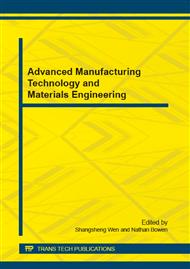p.163
p.167
p.171
p.177
p.182
p.187
p.191
p.196
p.203
Effect of Forming Parameters on Springback of Advanced High Strength Steel DP800
Abstract:
Springback is one of the main quality defects in the sheet forming. In this paper, numerical simulation is used to analyze the effects of blank holder force, friction coefficient, blank thickness, die corner radius and stroke on springback. The effect of blank holder force and blank thickness on springback is obvious. Springback decreases as the BHF and blank thickness increase. Increasing friction coefficient between tools and blank shows a good suppression effect on springback. Larger die corners increase the curvature of side wall and worsen the springback, but the springback of flange is reduced. The greater the stroke is, the larger the final springback will be.
Info:
Periodical:
Pages:
182-186
Citation:
Online since:
December 2014
Authors:
Price:
Сopyright:
© 2015 Trans Tech Publications Ltd. All Rights Reserved
Share:
Citation:


